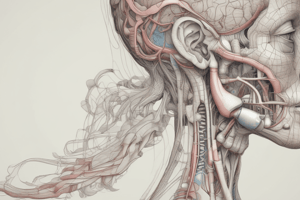Podcast
Questions and Answers
Which structure contains highly sensitive cells that send signals to the brain to identify smells?
Which structure contains highly sensitive cells that send signals to the brain to identify smells?
- Alveoli
- Bronchus
- Olfactory region (correct)
- Bronchioles
What is the function of the alveoli in the respiratory system?
What is the function of the alveoli in the respiratory system?
- Warming and moistening the air
- Trapping foreign particles
- Gas exchange between alveolar air and blood (correct)
- Defending the system from harmful particles
Which part of the respiratory system warms and moistens the air?
Which part of the respiratory system warms and moistens the air?
- Nasal cavity (correct)
- Bronchus
- Olfactory region
- Trachea
What is the main function of bronchioles in the respiratory system?
What is the main function of bronchioles in the respiratory system?
Which structure is lined with mucous to trap foreign particles?
Which structure is lined with mucous to trap foreign particles?
What is the function of bronchi in the respiratory system?
What is the function of bronchi in the respiratory system?
Which part of the respiratory system contains hair to expel trapped particles with rhythmic movements?
Which part of the respiratory system contains hair to expel trapped particles with rhythmic movements?
What should be included in every multiple-choice question for clarity?
What should be included in every multiple-choice question for clarity?
What is missing in this question?
What is missing in this question?
Flashcards are hidden until you start studying
Study Notes
Upper Respiratory Tract Structures and Functions
- Pharynx connects the oral to the nasal passage for both air and food
- Epiglottis covers the windpipe to ensure food passes into the oesophagus
- Larynx (voice box) contains vocal cords that vibrate when air passes through for sound production
Lower Respiratory Tract Structures and Functions
- Trachea (windpipe) is a muscular pipe surrounded by C-shaped cartilage for strength and flexibility
- Bronchus (right and left) and bronchioles have smooth muscles
- Alveoli are the basic units of the respiratory system where gas exchange occurs
Branching of Airways and Zones
- Conducting zone: from nose to terminal bronchioles, responsible for warming, humidification, and filtration of air
- Respiratory zone: includes respiratory bronchioles, alveolar ducts, alveolar sacs, and alveoli, where gas exchange occurs
Protective Mechanisms in the Respiratory System
- Ciliated epithelium in trachea and bronchi: warms and humidifies the air, and filters out foreign particles
- Mucus containing immunoglobulins disables pathogens
- Phagocyte cells (pulmonary alveolar macrophages, lymphocytes, plasma cells) engulf inhaled particles and bacteria
Alveoli and Gas Exchange
- Alveoli are the actual sites of gaseous exchange between the lungs and blood
- Each alveolus has a thin membrane for easy exchange of gases with capillaries
- Diffusion occurs between the alveoli and capillaries for gas exchange
Respiration Process
- Movement of air into and out of the lungs (breathing or ventilation)
- Gas exchange between the alveolar air and the blood in the lungs (external respiration)
- Gas transport in the blood between the lungs and body cells
- Gas exchange between the blood and the cells in the systemic capillaries of the body (internal respiration)
- Oxygen utilization and carbon dioxide production at the cellular level (cellular respiration)
Studying That Suits You
Use AI to generate personalized quizzes and flashcards to suit your learning preferences.




